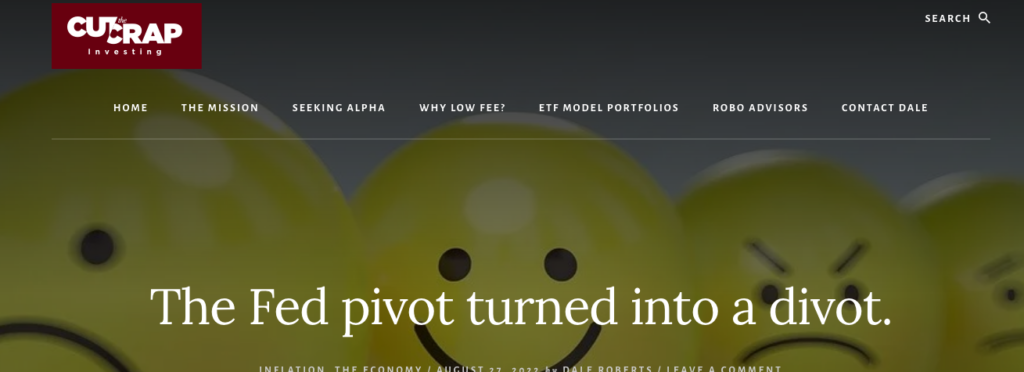By Dale Roberts, cutthecrapinvesting
Special to the Financial Independence Hub
It was a more than interesting week. Not much mattered until Jerome Powell (the U.S. Federal Reserve Chair) delivered comments on Friday. He came clean. Or at least he helped to reverse the delusion created by stock market enthusiasts that the Fed would ‘pivot’ and reverse course on the market-unfriendly series of rate hikes. Rates are going higher and they will stay higher. There will be some pain for consumers and business. Inflation must be crushed. They will do what it takes. The Fed pivot turned into a divot. The markets were not happy with the reality check.
In a Seeking Alpha article published just days before the Powell presser, Michael J Kramer of Cott Capital Management offered …
The futures, bond, and currency markets are already telling the world that there is no dovish pivot, and quite frankly, there probably never was a dovish pivot. The only market out there that hasn’t gotten the message appears to be the equity market.
If Powell can deliver a message that even a golden retriever (I own two goldens) can understand, then the equity markets’ day of reckoning will arrive in short order.
Also from Michael …
The futures knew it, bonds knew it, and the dollar knew it. Once again, the only market living on an alternate planet was equities …
Powell finally delivered a direct message
In his Jackson Hole speech, in the opening paragraph, he made it clear that his remarks would be shorter and the message would be more direct. That it was.
Very simply, rates still have further to rise, and once there, they will stay there for some time. In the following paragraphs, I have borrowed from Michael and others, I will avoid quotes for readability. My own commentary is in the mix.
Powell offered that reaching an estimate of the longer-run neutral rate is not a place to pause or stop. He said the June FOMC projections suggest rates would rise to just below 4% through the end of 2023 and that history warned against loosening policy too soon.
It’s evident that the Fed is aware of the mistakes made in the 1970s and 1980s with the stop-and-go monetary policy approach that led to even higher rates, and the Fed appears determined not to repeat those mistakes. There can be no 70’s show rerun.
Fed Chair Jay Powell said:
Restoring price stability will likely require maintaining a restrictive policy stance for some time. The historical record cautions strongly against prematurely loosening policy.
Powell noted that fighting inflation will take a sustained period of below-trend growth and a softening labor market, which could bring pain to households, and are the costs of reducing inflation. In the third paragraph of his speech, it’s right there. The Fed is willing to sacrifice growth and face rising unemployment to bring inflation down. He is telling the market there will be no “pivot” anytime soon.
Inflation is driving the bus
The Fed chair said central banks need to move quickly, warning historical episodes of inflation have shown that delayed reactions from central banks tend to come with steeper job losses.
“Our aim is to avoid that outcome by acting with resolve now,” Powell said.
The following image is not a live video, but an example of the headlines that ‘spooked’ the markets.
Federal Reserve Chairman Jerome Powell on Friday said the central bank’s job on lowering inflation is not done, suggesting that the Fed will continue to aggressively raise interest rates to cool the economy.
Get the inflation-killing job done
“We will keep at it until we are confident the job is done,” Powell said in remarks delivered at the Fed’s annual conference in Jackson Hole, Wyoming.
“While the lower inflation readings for July are welcome, a single month’s improvement falls far short of what the Committee will need to see before we are confident that inflation is moving down,” Powell said Friday.
The central bank has delivered four consecutive interest rate hikes over the last six months, moving in June and July to raise rates by 0.75%, the Fed’s largest moves since 1994. By raising borrowing costs, the Fed hopes to dampen demand by making home buying, business loans, and other types of credit more expensive.
Powell said more rate hikes will be needed, with “another unusually large” increase still on the table for the Fed’s next meeting in September. The Fed chair reiterated that “at some point,” the Fed will move to slow the pace of its price increases.
More from Powell …
In current circumstances, with inflation running far above 2 percent and the labor market extremely tight, estimates of longer-run neutral are not a place to stop or pause.
The Fed chair said central banks need to move quickly, warning historical episodes of inflation have shown that delayed reactions from central banks tend to come with steeper job losses.
“Our aim is to avoid that outcome by acting with resolve now,” Powell said.
Combined with the crunch of expensive credit, Powell warned households and businesses may feel some pain as interest rates increases continue. Powell …
These are the unfortunate costs of reducing inflation. But a failure to restore price stability would mean far greater pain.
Lessons from that 70’s show
That commentary, pointing to the lessons officials learned from studying the Fed’s struggle to combat high inflation in the 1970s and 1980s. As I have written for quite some time, central bankers have to kill inflation ‘real good’ the first time. There’s no playing around with the threat of stagflation. Let’s take our lumps now.
They have to smack the consumer, real hard. The Fed is using a blunt instrument to fight inflation. They can only go at the demand side of the equation.
The Volcker pivot to divot
Here’s a history lesson on the actions of the Fed chair during the period of stagflation of the 70’s and early 80’s.
For more on Volcker – Paul Volcker And 1982. Why Now Isn’t Then.
From August ’79 through April 1980, Volcker raised interest rates from around 11% to 17.5%. Inflation over this period rose from 11.8% to 14.5%. A pause in inflation pressures in the summer of 1980 prompted Volcker to make an error — the Fed slashed interest rates. By July 1980, benchmark rates were below at 9%, the lowest in two years. Inflation was trending down but still running north of 12%. Another rate-hiking cycle began.
He then went on raise rates significantly, and eventually put a R.I.P. stagflation note on the gravestone. In the chart below, the grey areas represent recessions.

An ‘early ease up’ is a mistake that Powell is looking to avoid.
Inflation data
Inflation data on Friday morning showed prices in the U.S. rose by 6.3% on a year-over-year basis in July, a notch down from the 6.8% pace measured in June. When stripping out food and energy, the Personal Consumption Expenditures Index showed prices rising by 4.6% compared to a year ago — still well above the Fed’s target of 2%.
For the week, the Dow fell by 4.2%. The S&P 500 and Nasdaq Composite were down 4% and 4.4%, respectively. Canadian stocks were down just 0.4% for the week.
Who can ignore all of the above?
It’s all good financial press fun that the investor in the accumulation stage can ignore. You can carry on, add monies on a regular schedule. Stick to your investment plan. Pay attention to valuation not the noise and confusion.
You can just watch it all – for entertainment purposes only. And it is entertaining if you like geeky economic and market ‘stuff’.
If you’re in the retirement stage, you should already be prepared for all of the uncertainties. You might be ready with a version of an all-weather portfolio.
Here’s an example of an ETF portfolio for retirees and the U.S. stock portfolio for retirees.
For more, see my Sunday Reads.
 Dale Roberts is the owner operator of the Cut The Crap Investing blog, and a columnist for MoneySense. This blog originally appeared on Cut the Crap Investing on August 27, 2022 and is republished on the Hub with permission.
Dale Roberts is the owner operator of the Cut The Crap Investing blog, and a columnist for MoneySense. This blog originally appeared on Cut the Crap Investing on August 27, 2022 and is republished on the Hub with permission.


